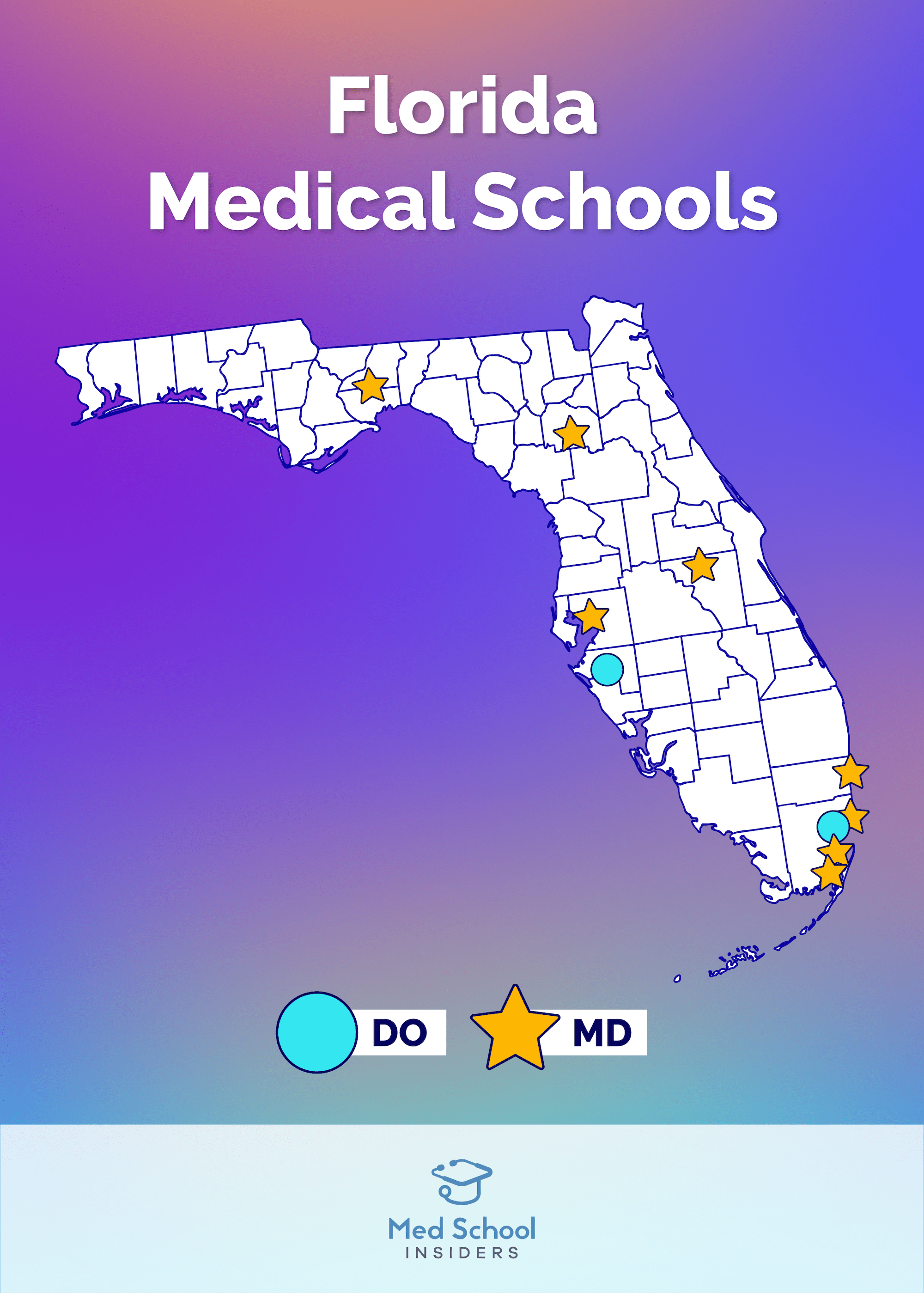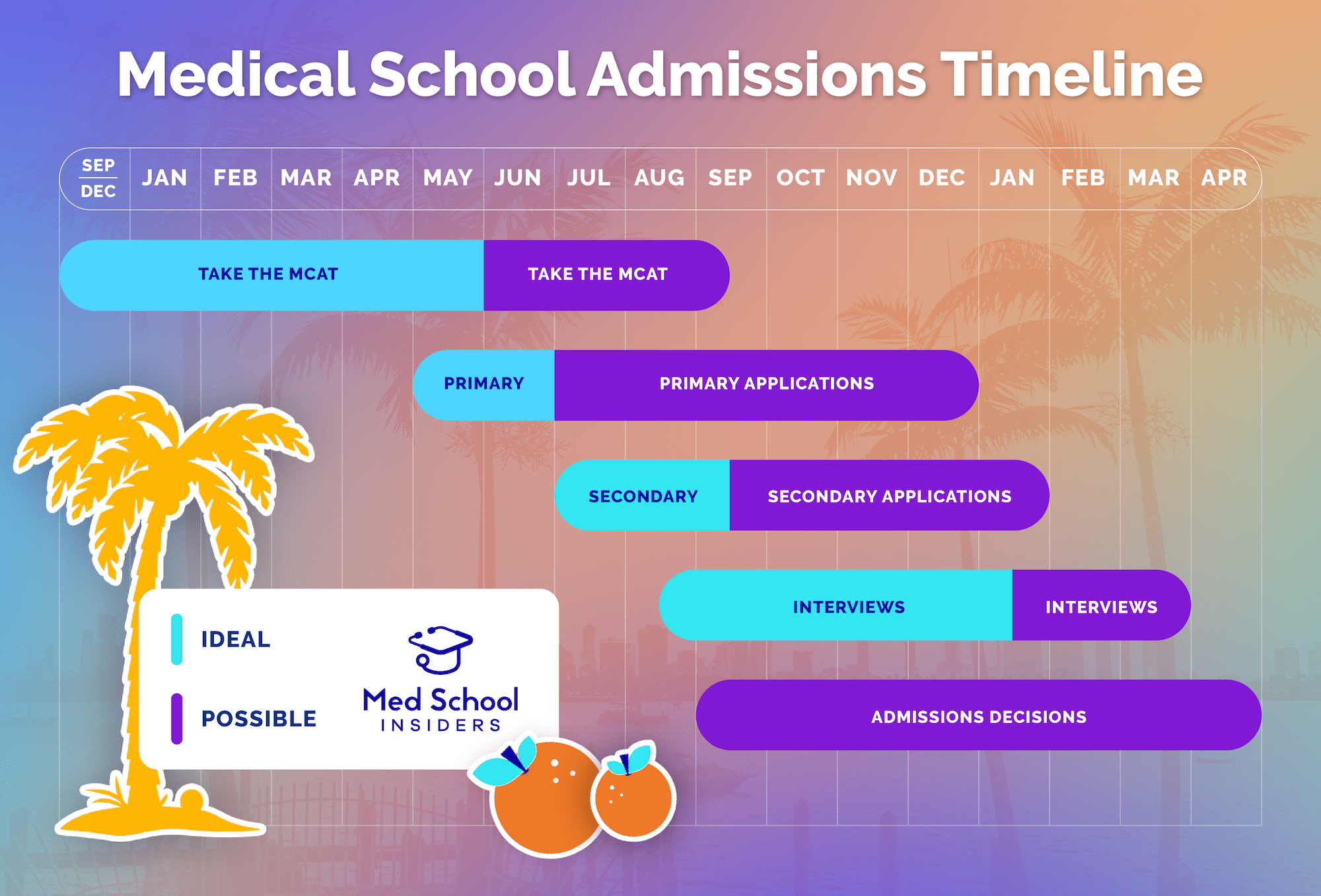How Much Do Doctors Actually Make?
Stop relying on the average doctor salary. We break down the pay difference between specialties and how RVUs & procedures impact your compensation.

Are you considering applying to medical school in Florida? If you’re looking for an opportunity to work with a wide variety of different people while serving one of the most diverse populations in the country, look no further than the Sunshine State. Of course, the year-round sunshine, over 500 beaches, rich culinary scene, and countless amusement parks offer plenty of reasons to make this state your home for the next 4+ years!
But what’s it like to attend medical school in Florida, and how do you get accepted?
In this post, we’ll break down everything you need to know about going to medical school in Florida, including where the medical schools are located, what it’s like to live in Florida, how to apply, and tips for gaining acceptance to medical schools in Florida.
Are you applying to other states? Utilize our State Guide series for an in-depth look at the application process in various states across the country.
There are 11 medical schools in the state of Florida. 8 of them are MD (allopathic) medical schools, and 3 are DO (osteopathic) medical schools.
This is a notable number of schools. The only states that have more medical schools than Florida are New York, California, and Texas.
Allopathic Medical Schools in Florida (MD)
Classifying which Florida medical schools are the best is a challenge, as what’s best for one student may not be best for another.
From an admissions standpoint, this is how competitive your hard metrics must be to be considered at a Florida medical school. These numbers are based on 2023 matriculant data from MSAR.
These Florida schools are ranked from highest to lowest median GPA.
| Medical School | Median GPA |
|---|---|
| University of South Florida Health Morsani College of Medicine | 3.95 |
| University of Florida College of Medicine | 3.94 |
| University of Central Florida College of Medicine | 3.94 |
| Florida Atlantic University Charles E. Schmidt College of Medicine | 3.88 |
| Florida International University Herbert Wertheim College of Medicine | 3.89 |
| Florida State University College of Medicine | 3.87 |
| Nova Southeastern University Dr. Kiran C. Patel College of Allopathic Medicine | 3.77 |
| University of Miami Miller School of Medicine | 3.89 |
These Florida schools are ranked from highest to lowest median MCAT.
| Medical School | Median MCAT |
|---|---|
| Florida State University College of Medicine | 509 |
| University of South Florida Health Morsani College of Medicine | 520 |
| Florida Atlantic University Charles E. Schmidt College of Medicine | 513 |
| University of Florida College of Medicine | 515 |
| University of Miami Miller School of Medicine | 515 |
| University of Central Florida College of Medicine | 514 |
| Nova Southeastern University Dr. Kiran C. Patel College of Allopathic Medicine | 513 |
| Florida International University Herbert Wertheim College of Medicine | 509 |
Florida has a range of medical schools across the state that serve diverse populations, which vary depending on the city in which the school is located.
There are many medical schools in Florida, and few are located close to one another. The schools are spread across the state, which contributes to the distinctions of each program.
However, there are exceptions. The FIU Herbert Wertheim College of Medicine and the University of Miami (UM) Miller School of Medicine are both located in Miami, approximately 40 minutes apart. NSU MD and NSU DO are located on the same 314-acre campus in Fort Lauderdale.
The UF College of Medicine in Gainesville is over 5 hours away from Miami, 3 hours away from Tampa Bay, and 2 hours away from Orlando. Miami is 4 or more hours away from Orlando, where the UCF College of Medicine is located, and 4.5 hours away from Tampa Bay, where the USF Morsani College of Medicine is located. UCF and USF are approximately 1 hour and 45 minutes apart.
The FSU College of Medicine has six regional campuses spread across the state: Daytona Beach in northeast Florida, Fort Pierce in southeast Florida, Orlando in central Florida, Pensacola in northwest Florida, Sarasota in southwest Florida, and Tallahassee in north Florida.
You get the idea. Unlike other states, where medical schools are predominantly clustered in 1-2 major cities, Florida’s medical schools cover the whole map of the state. Public transportation will be available in major cities, but if you want to leave your city and travel around the state, you’ll need a car.
The most populous Florida city is Jacksonville at 971,319. The populations of Miami, Tampa Bay, Orlando, Fort Lauderdale, Gainesville, and Boca Raton are 449,524, 398,173, 316,081, 183,146, 145,214, and 99,909, respectively.
Florida is the third-most populous state in the United States, with a population of over 21 million. Since it’s such a large state, it’s to your advantage to own a car. In fact, some people believe having a car is a necessity on the same level as food and water. Even in major cities like Miami, public transportation is limited.

So, how much does medical school cost in Florida?
| Florida Medical School | Yearly Tuition In-State | Yearly Tuition Out-of-State |
| Florida Atlantic University Charles E. Schmidt College of Medicine | $31,830 | $67,972 |
| Florida International University Herbert Wertheim College of Medicine | $38,014 | $69,514 |
| Florida State University College of Medicine | $28,987 | $68,619 |
| Nova Southeastern University Dr. Kiran C. Patel College of Allopathic Medicine | $73,666 | $73,666 |
| University of Central Florida College of Medicine | $29,680 | $56,554 |
| University of Florida College of Medicine | $36,657 | $48,913 |
| University of Miami Miller School of Medicine | $55,414 | $55,414 |
| University of South Florida Health Morsani College of Medicine | $33,726 | $54,916 |
| Burrell College of Osteopathic Medicine (Florida Campus) | $67,906 | $67,906 |
| Lake Erie College of Osteopathic Medicine Bradenton Campus** | N/A | N/A |
| Nova Southeastern University Dr. Kiran C. Patel College of Osteopathic Medicine | $71,617 | $71,617 |
View the most recent AAMC tuition data.
Note that there are clear and significant tuition breaks for in-state Florida residents, with some schools charging local students less than half that of out-of-state applicants. Of 8 schools, the only two exceptions to the in-state breaks are the University of Miami Miller and Nova Southeastern University, which charge the same tuition for both in-state and out-of-state students.
Tuition is far from your only medical school cost. There are many other financial factors to consider, including housing, transportation, food, exercise, and events. Unfortunately, the cost of living in Florida is above the national average.
The average living wage in Florida is $17.24, but the minimum wage is currently $10. The cost of living varies by state, with Miami being known for incredibly expensive housing, along with other necessary expenses. The high cost of living can be partially attributed to Florida’s notable tourism industry, which results in high demand for housing in cities such as Miami, Orlando, Fort Lauderdale, and Tampa.
You must also factor in the cost of medical school applications, which compound quickly across primary fees, secondary fees, exam fees, study resources, and interview travel costs.
In addition to significant tuition breaks for in-state students, many Florida schools also have a massive preference for choosing Florida applicants.
| Florida Medical School | In-State Applicants | Out-of-State Applicants | In-State Matriculants | Out-of-State Matriculants |
|---|---|---|---|---|
| Florida Atlantic University Charles E. Schmidt College of Medicine | 2151 | 2072 | 57 | 22 |
| Florida International University Herbert Wertheim College of Medicine | 2487 | 3577 | 106 | 13 |
| Florida State University College of Medicine | 2688 | 3738 | 120 | 0 |
| Nova Southeastern University Dr. Kiran C. Patel College of Allopathic Medicine | 2112 | 3335 | 43 | 19 |
| University of Central Florida College of Medicine | 2382 | 2581 | 84 | 36 |
| University of Florida College of Medicine | 2480 | 2856 | 119 | 16 |
| University of Miami Miller School of Medicine | 2160 | 6786 | 152 | 83 |
| University of South Florida Health Morsani College of Medicine | 2438 | 3183 | 80 | 50 |
Most schools strongly prioritize Florida residents. While a few schools have an approximate 50/50 ratio of in-state vs out-of-state students, other schools only accept a handful of out-of-state applicants. The extreme example of this is the FSU College of Medicine, which did not accept out-of-state applicants at all in 2024.
If you are a Florida resident, this is great news, as you not only stand to receive significant tuition breaks if you stay in the state to study, but your application will also be favored over those from other states. That said, you will still be up against thousands of fellow Floridians.
If you’re a non-Florida resident but have your eye on the Sunshine State for your medical education, know that you’ll need to go above and beyond to make your application stand out. Always check in-state vs out-of-state matriculant numbers in advance to get a sense of your chances, and if a Florida school is at the top of your list, begin planning your application narrative as soon as possible, as you’ll be competing against thousands of other applicants for a handful of available spots.
Here’s What You Need to Know About Applying to Out-of-State Medical Schools.
Florida is known as the Sunshine State because of its warm, sunny climate and numerous beaches. The state is home to Disney World, Universal Studios, the John F. Kennedy Space Center, Everglades National Park, and the Florida Keys.
With so many major attractions, it’s no surprise that Florida is the most visited state by overseas travelers, even outranking New York (though not by much). Of the top 5 most visited US cities, Miami places 2nd, followed by Orlando, with New York City at the top of the list. Florida had an estimated 135.02 million tourists in 2023.
Most of Florida has a subtropical climate with mild winters and hot summers full of sunshine, hence its nickname. From June to September, the weather is consistently hot and muggy, with daytime temperatures ranging from 88°F to 91°F, and numerous thunderstorms occur. Temperatures in the wintertime range from 52°F in the north to 20°C, or 68°F, in the far south, such as Miami and the Keys.
The peak of hurricane season is from August to October.
Florida has a number of popular sports teams, including two NHL teams, two NBA teams, two MLB teams, and 3 NFL teams. It’s definitely a state that takes pride in its sports.
If you’re a foodie, Florida is home to many iconic foods, such as key lime pie, Cuban sandwiches, stone crabs, and Florida orange juice. In 2023, Florida produced $263 million worth of citrus.
If you like beaches and watersports, there are over 500 beaches in Florida and over 1350 miles of coastline.
Of course, it can’t be all sunshine and oranges. The number of tourists in Florida can be overwhelming. Although each area of Florida is distinct, the cost of living is above the national average, and Miami’s is particularly astronomical, which can be particularly challenging for medical students.
Additionally, regardless of whether you consider this a positive or negative development, it is worth noting that the political climate in Florida is increasingly right-leaning, making it a much more conservative state than it was in the past, and it is likely to continue leaning even further to the right.
This impacts healthcare a great deal, as the government partially funds healthcare and, in some cases, dictates what procedures can and can’t be performed or taught in medical school, such as outlawing abortion six weeks after a person’s last menstrual period.
To apply to any allopathic (MD) Florida medical school, you’ll use the centralized medical school application processing service: AMCAS (American Medical College Application Service).
The service submits your application to as many medical schools as you apply to, so that you only need to submit one primary application.
If you are only applying to osteopathic medical schools in Florida, skip to the next section, which outlines the DO application process for applying using AACOMAS.
Here’s what you need to know about applying to allopathic medical school in Florida.
Your primary application is made up of several components, including college transcripts, MCAT score, personal statement, letters of recommendation, and a Work and Activities section.
Additionally, depending on the schools you’re applying to, you may need to complete a situational judgment test—either the Casper test, the PREview exam, or both.
The University of Miami and Florida Atlantic University both require a Casper test. No Florida school currently requires a PREview exam; however, many schools are using PREview data for research purposes, which may indicate a future plan to adopt the test. View the full list of schools requiring Casper and schools requiring AAMC PREview.
Since school requirements can change year-to-year, always check and double-check the requirements of each school you are applying to well before application season and leading up to your submission to ensure nothing is overlooked.
Save our Casper Test Guide and AAMC PREview Guide for everything you need to know about these tests.
When it’s time to prepare, utilize our Casper AI course and PREview AI course, which both generate instant feedback, including immediate personalized evaluation and emotion detection analysis. The course includes unlimited practice problems, which means you’ll have endless opportunities to refine your skills, adapt to various scenarios, and truly understand the nuances of both situational judgment tests.
After submitting your primary application, secondary application requests typically arrive within two to four weeks. You must submit your secondaries to each school separately, unlike your primary application. Expect to receive secondaries from most of the schools to which you apply. We’ll cover secondary applications for Florida medical schools in more detail in the tips section below.
If your secondary stands out, you’ll receive an interview. Interview season runs from September into the following year.
The complete application process explained: How to Get Into Medical School.
In addition to application components, the following key dates and deadlines are critical to your success in applying to medical school.
The AMCAS application opens the first week of May, and submissions begin at the end of May or early June. If you want to start medical school in the fall of 2027, you need to start the application process in the spring of 2026.
Each school has its own technical deadlines, but these should largely be ignored. Applications are evaluated on a rolling basis, meaning schools review applications in the order they are received. The first people to submit their primary application are the first to receive secondaries, and then the first to submit their secondaries are the first to receive interview invites.
The longer you wait on any step of your application, the worse your chances of acceptance.

Here’s what you should be working on month-by-month: Medical School Application Timeline and Monthly Schedule. (Updated every application cycle.)
Applying to osteopathic (DO) medical schools in Florida requires a different application system, but the process is much the same as MD schools.
Instead of applying through AMCAS, you’ll apply through the American Association of Colleges of Osteopathic Medicine Application Service (AACOMAS).
The primary application is composed of your transcripts, MCAT score, a personal statement, letters of recommendation, and an experiences and achievements section.
The only difference in how you prepare your application is that you must answer why you want to pursue osteopathic medicine specifically in your personal statement. Additionally, to be a competitive applicant, you’ll want to show osteopathic experience to illustrate your interest in osteopathic medicine and have at least one letter of recommendation from a DO.
Utilize our AACOMAS Application Guide for DO Schools.

Because the medical schools in Florida are so spread out across the state, each school has a distinct patient population, community, cost of living, and city vibe. As you research Florida schools, you’ll need to go far beyond researching the state itself to dig into the differences of each of the cities in which the medical schools are located.
Dig deep to learn what the school prioritizes, what it’s like to attend the specific medical school, and what the city is like to live in. There’s a very big difference between living in the densely populated, party atmosphere of Miami and living in the smaller, more laid-back beach town of Boca Raton. The cost of living from one city to the next also reflects these stark differences.
Determine what you want from a school, the patient population you want to serve, and the type of city you want to call home for at least 4 years. As you get more serious about narrowing down your top-choice school, visit the cities themselves to ensure they are the right fit for you. Don’t just imagine what it would be like to live there—go and see for yourself.
Florida medical schools are known for having particularly long secondary applications. All the schools have hefty expectations, with some including as many as 13 questions to answer. If you’re applying to multiple Florida medical schools, you’ll need to set plenty of time aside to complete these lengthy secondary applications.
The length of Florida secondary applications is a clear sign that schools put heavy emphasis on this aspect of the application. If you want to stand out, you’re going to have to do so in your secondaries.
Use your secondaries to continue your application narrative. What is the story you want to tell the school about yourself? What important qualities do you want them to know you possess?
This Is How to Develop a Cohesive Narrative for Medical School Applications.
How can you use these extra questions to help the admissions committees understand why you’d make a good fit for their medical school program?
Remember, it’s not just about why you want to attend that medical school in particular. Schools are looking for applicants who will help contribute to the institution’s goals and values. What is it about your experience, values, interests, and goals that align with that program in particular, and how will you specifically help the program reach its goals?
While you’ll be able to reuse some aspects of your secondaries from one application to the next, take time to tailor each secondary application to the specific school you’re responding to. Cookie-cutter answers that sound like they could apply to any school will not get you noticed, especially if you are vying for one of those few prized out-of-state spots.
Use the Med School Insiders Secondary Database to prepare for Florida applications. You can view every secondary question from the previous application cycle, as well as prior years, to better understand what to expect from your secondary requests.
These are the previous secondary prompts for all Florida medical schools:
While politics is largely kept out of the conversation when choosing a medical school, Florida is an exception. No matter the political party you support, it’s important to understand that Florida is a right-leaning state that is continuing to grow staunchly Republican.
This is an essential consideration for medical students, as the state’s government dictates what can and can’t be taught, as well as what procedures can or can’t be performed in its hospitals.
For example, if you’re interested in OB/GYN, the state’s government restrictions mean you will not learn the full spectrum of your specialty. The Florida government has outlawed abortion after six weeks since the pregnant woman’s last menstrual period.
Again, whether you agree or disagree, the unfortunate reality is that the same surgical techniques for abortion are used when a patient experiences a miscarriage and is hemorrhaging, and medical students are not allowed to learn these potentially life-saving techniques. This means, down the line, if a patient comes into the hospital after suffering a spontaneous miscarriage, young doctors trained in Florida won’t know how to help them.
Not being able to learn the full spectrum of care for your specialty may be a deciding factor in whether or not you continue your medical education in Florida. While many OB/GYN physicians are leaving the state, others are choosing to stay and advocate for Florida’s citizens, providing care to those who need it most.
Although Florida schools strongly favor in-state applicants, there are ways for out-of-state applicants to stand out.
Florida is one of the most diverse states in the US, if not the most. There are very large populations of Spanish, Caribbean, and Haitian Creole people, so understanding the nuances of and having personal experience with these cultures will help you stand out.
Considering that over 20% of the population speaks Spanish, knowing how to speak it is a major plus. If you don’t speak Spanish and you have your heart set on Florida, add Duolingo practice to your list of daily chores. Consider taking a Spanish language class at school or enrolling in an intensive summer course to propel your progress.
From an emphasis on primary care to caring for rural, underserved populations to focusing on geriatrics to prioritizing research, medical schools in Florida run the gamut in terms of what they offer. A school’s focus very much depends on where it’s located.
But beyond the medical program and school resources, what matters most is whether or not you enjoy the community and environment you’ll call home for the next four or more years.
Each city has its own unique flair, and across most of that state, you’ll need to be comfortable with millions of tourists pouring in each year to share in the sunshine, beaches, and countless tourist attractions.
Florida offers over 500 beaches, watersports, a long list of sports teams to root for across hockey, basketball, baseball, and football, a rich culinary scene, and all the amusement parks you could ask for—including Disney World! But beyond the sunshine and superficial aspects, Florida offers an opportunity to work alongside a variety of different people while serving diverse populations across the state.
Regardless of the states where you apply, admission committees are looking for mature, well-rounded students who will add to the student body of their school. It’s not enough to simply check off the boxes. You must show why you are an ideal fit for the schools you apply to and what you can specifically offer the program to help accomplish its mission.
Med School Insiders can help you craft a narrative-driven application that will get you noticed by Florida medical schools, as well as any schools at the top of your list. We have a range of services to help you craft a well-rounded application, from one-on-one guidance to application editing to mock interviews to our Ultimate Research Course.
Whether you need a comprehensive application strategy, detailed essay feedback, or interview preparation, our services are tailored to meet your individual circumstances and goals. Don’t leave your medical school dreams to chance—contact us today to find out how you can transform your application from good to truly memorable.
Thank you to Sanjana Satish, MD, MPH, a University of Miami Miller School of Medicine graduate, for serving as our Insider contributor for this guide.
Stop relying on the average doctor salary. We break down the pay difference between specialties and how RVUs & procedures impact your compensation.

Are you built for the Emergency Department? We reveal the 6 signs that prove you’re destined to succeed in emergency medicine.